
Negotiating Leaking Spaces
by BECKY NEVIN BERGER
- View Becky Nevin Berger's Biography
Becky Nevin Berger is an artist working in installation, participatory art, and practice led research.
Negotiating Leaking Spaces
Becky Nevin Berger
Observing my relationship with my environment/s has made the leakiness of subjectivity and space tangible. This is echoed in the common effects that I have found between image making and space making. I began a practice-led research PhD in the Sculpture Workshop at the Australian National University in 2012. This research began with the desire to articulate the role of the aesthetic in connecting subjectivity and environment. It evolved to also consider how it is that we create spaces and what role creative practice may play in this. Mixed media installation practice that spans image making and sculpture has been vehicle for this inquiry. The key concepts of subjectivity, aesthetics and environment proved to be big, broad fields in themselves, their boundaries difficult to locate and fix on. There have been three thematic fields in my research, loosely chronological and frequently overlapping and leaky. The first concerns my relationship to the Victorian landscape which raised questions about how socio-historical context shapes my perception of my own position within the landscape. The second concerns my domestic home as a field to examine how it is that we make and share spaces through seemingly predictable routines of ordinary life. The third concerns the creation of spaces that use the aesthetic as a means to interface with subjectivity and promote particular engagements with its world. Each of these three fields enables different relationships and dynamics between the subject and the environment to become visible.
When I use the term aesthetic I am referring to meaningful sensuousness. This differs from the nineteenth century hedonistic conception of aesthetics which was concerned with the disinterested appreciation of beauty (Korsmeyer 127-28). Aesthetics as a meaningful sensuousness is when sensorially perceivable qualities convey information about the relationships between different things, concepts and contexts. Through experiencing this meaningful sensuousness we are able to perceive the quality and dynamics of each thing, and the overall relationship they are in, in felt rather than verbal thought. Richard Shusterman (79) notes that the aesthetic extends between, and can be both, object and subject. Katya Mandoki (12) insists that it only exists when there is a human subject there to perceive it. The aesthetic depends on the faculty of human experience and I argue that it is in fact intrinsic to experience. This term has been central to this research because it provides a means to capture the physical and cultural interconnection of body and world.
The Landscape
In mid-December 2013 I would complete the last step in an Artists in Schools residency project, creating an artefact that would be crucial to my own practice-led research. Guided by the students' count down I let a large helium filled weather balloon pull a triangular frame from my hands. Mounted on each point of the triangle was a GoPro Camera, a GPS tracker and an audio beaker. The big white balloon ascended into the perfectly clear blue sky above us. I had worked with the students over twenty weeks. Our project took Eugene von Guerard’s expeditions to south west Victoria as a starting point for an arts led examination of our interconnection with our environment. This final art work would give us a visual image of that interconnection, beginning on the school oval in the township of Macarthur and ending approximately 65,000ft above in the stratosphere. As expected the helium expanded in the thinning air bursting the weather balloon somewhere between 65,000 and 80,000ft. The rig followed the predicted flight path. Aided by a parachute, it landed intact just shy of Lake Bolac in Victoria's Western District. I retrieved it that same day and was able to send a copy of the footage to the school in time for their end of year concert. That is where the students and I parted ways; I can only guess what their reception of that footage might have been.
Inside Out from Unlikely Journal on Vimeo.
Becky Berger Nevin with students from Macarthur Primary School, Western Victoria, "Gaia is Symbiosis as seen from Space", digital video, 2013.
My PhD research began by critiquing my own position within the landscape. I grew up in North East Victoria in an area farmed by my ancestors since the 1860s. Those foothills and valleys, eucalypts and paddocks, rivers and manmade lakes look just as though they always had been that way. Even now the sense of home that I feel in that terrain makes it difficult to pierce through its constructed picturesque. I moved to the Victorian coastal city of Warrnambool in 1999. I struggled to process the new terrain in which I found myself. The gum trees I was accustomed to were scarce, tall dark imported Norfolk pines instead lined most major roads. Stone fences, cleared flat paddocks and Cyprus trees in the surrounding areas all seemed to emphasise the European attempts to subvert the indigenous landscape and replace it with their own. The terrain seemed utterly foreign. The tension of this perception created the starting point for my PhD inquiry. Through practice-led observation I saw how particular socio-historic factors shaped the dynamics of this relationship, in particular my ancestral lineage which connected me directly to the white farming practices that transformed the landscape.
I observed the landscape’s features, its topography and vegetation, the built environment and other human interventions. I became increasingly aware of the role my perception played in how I felt and read each place. In his Art of America documentary series Andrew Graham-Dixon describes how a city can be read as an image that illustrates its own socio-economic distribution, its skyscrapers like graphs indicating where money congeals within the urban centre. Driving away from the central business district he draws on a passage written by Upton Sinclair in 1906 which correlates a visual ugliness with the expanse of slums that extended away from the Chicago city centre. Out Dixon’s car window the gradual decline in prosperity becomes visible as neighbourhoods appear more dated, industrial and derelict buildings become more common and streetscapes wear the markings of insufficient civic funds. In examining the aesthetics of my own reading of the landscape the need arose to pull back into the socio-historical past that contextualised my current position. In this way I might unlock the multiple meanings in the terrain around me.
I found an entry point into my landscape’s past through an 1855 colonial painting by Eugene von Guerard in the Warrnambool Art Gallery collection. Tower Hill records an extinct volcanic site just west of Warrnambool. It shows pristine and diverse indigenous vegetation and seems to capture a moment of first contact between the European gaze and the Aboriginal people. Engaging this painting as I critiqued my own position within the landscape drew out uneasy socio-historical precursors to my subjectivity: this ‘other’ landscape, the one painted and the present one in which I now lived, enabled me to finally experience my own foreignness within the whole Australian landscape.
Von Guerard completed Tower Hill after an expedition to the Western District’s vast volcanic landscape. He used the European conventions of the picturesque and the sublime to portray the volcanic curiosity. The meticulous painting famously enabled the site’s accurate revegetation a century later (Bonyhady, 394-351) and captures precisely the geological contours of the crater, its lake and island hills. Tower Hill bears the marks of someone who has searched the landscape before them in order to record it in most faithful detail: a visitor to the landscape who looks upon it with eyes foreign to it. A Gundjitmara camp is nestled in the left of the painting’s foreground. Colonisation’s advance is marked by the inclusion of a ship, newly cleared farmland and the settlement of Port Fairy in the painting’s background.
There is a common discourse which critiques colonial landscape painting’s complicity in the system of mapping, naming and claiming used to enforce empire’s acquisition and domination of new lands. One visual regime of colonisation, asserts Terry Smith (268), is the practice of aestheticisation. Among these is the picturesque. The figuring of new and uncertain lands through the familiar aesthetic matrix of the picturesque diffused the fear of the new terrain and reified the presence of the colonisers while omitting their brutality. This critique resonates with the unease accompanying my own position within the Australian landscape. It also reveals an aspect of the role of aesthetics in bonding body and environment. As an artist who has spent time searching this same terrain with my eyes I must consider the experience of von Guerard himself. The process of creating an image such as Tower Hill requires an attentive, repetitious looking and sketching. Such a process cannot help but develop an understanding and even a bond between artist and the terrain. Sumanthis Ramaswamy (12) asserts that we should engage in empire’s images not merely as reflections. Rather ‘we ought to be committed to these objects of knowledge in and of themselves, as world making and world disclosing.’ This productivity of image making and its utility in the formation of our relationships with our environment signals a way forward for my critique of my own position within the landscape: to destabilise the picturesque imagery suspended in my subjectivity through reckoning with its contexts and effects and by searching out new images/imaginings of this landscape.
The video captured the Macarthur school ground and quickly expanded its frame - the volcanic topography of Mount Eccles soon visible - and then the blue of the coast. The expanding landscape spins as the film records the ascent. The patchwork of farmland, tree plantations, wind farms, occasional townships and areas of national and state parks grows continuously over the film’s hour long duration. The contrast between the land and sea is mesmerising. The contour of the coastline aids in positioning one’s vantage. A dark patch between the bays of Port Fairy and Warrnambool can only be Tower Hill. The speed of the spinning declines as the camera draws up into the upper altitudes. The Grampians can be seen as a large dark horse shoe on the terrain far below, in the other direction, stretching out toward the sea another dark area identifies the Otway Ranges - beyond it the sky is smudged brown by the air of Melbourne. The vast landscape below is a mosaic of yellow, orange and brown rectangles - almost every bit altered and formed by human hands. The white bow of the horizon bends with the camera’s movement exaggerated by its fish eye lens. At an altitude which must be higher than 60,000ft the camera captures the hazed overlapping and contrast between the dark cold presence of space and the light infused atmosphere of earth.
The Domestic
After a year examining my relationship to the landscape my supervisors suggested that focusing on a different field would further develop my understanding of the role of the aesthetic in bonding the subject and the environment. I was advised to concentrate solely on the interior of my domestic home.
I recorded the interior life of my house in a visual diary and used my camera to search the space. I was cautious not to embellish my images and photographed each scene as I found it. I was concerned not to reduce each sight into an account of a singular experience of space: I documented the after effects of familial interactions to capture the intersections of multiple subjectivities; I made serial images of my bedroom, dining table and bathroom in order to convey the overlapping of experiences and the continuous flow of change through habitual space. I found myself pushing hard against a physicalist sense of measurable space. I challenged myself to convey instead its multi-dimensional fullness through the single point perspective of my camera and the singular fragments of time it fixed. Through these biopsies of my ordinary world I became increasingly aware of the lineages that connected each site/sight to the multiple other times, spaces, subjectivities and intentions that eluded the photograph’s borders and its visual field.
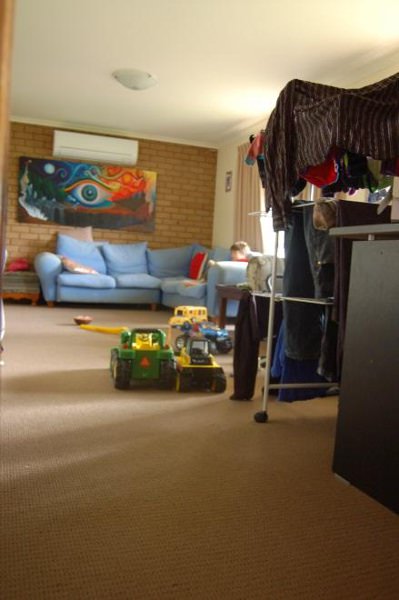
Becky Nevin Berger, Untitled Photographs, Domestic Nexus Series, 2013
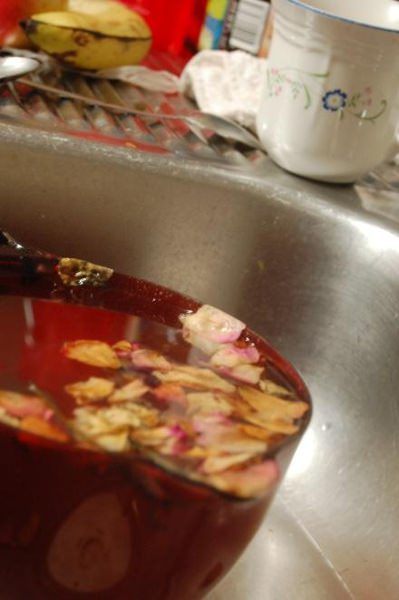
Becky Nevin Berger, Untitled Photographs, Domestic Nexus Series, 2013
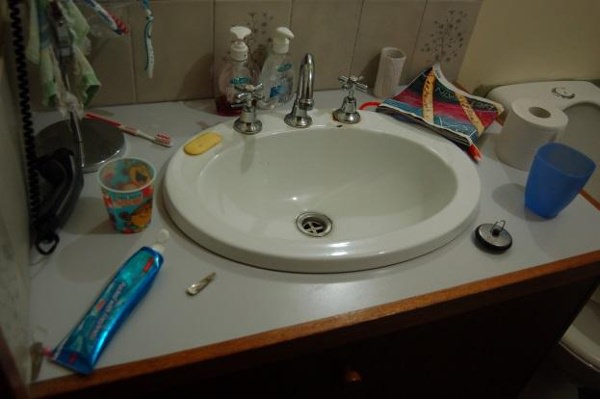
Becky Nevin Berger, Untitled Photographs, Domestic Nexus Series, 2013
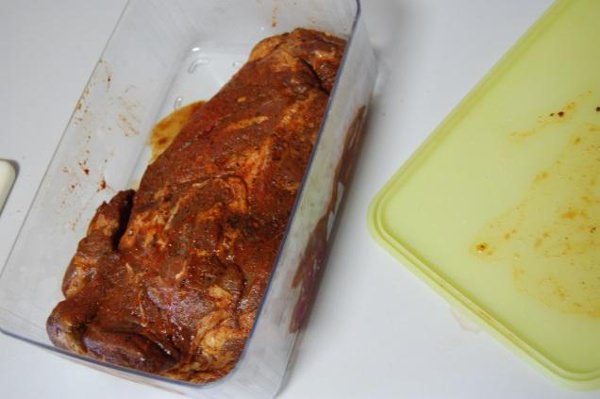
Becky Nevin Berger, Untitled Photographs, Domestic Nexus Series, 2013
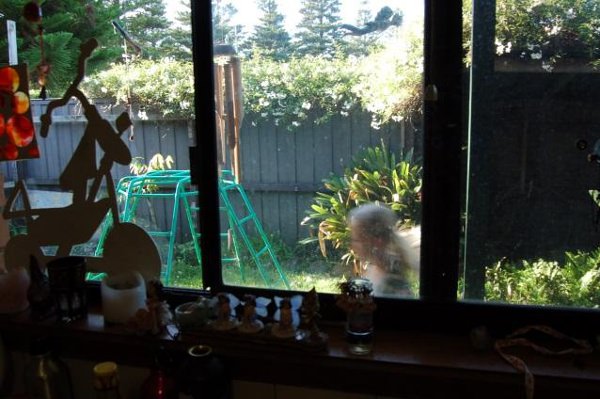
Becky Nevin Berger, Untitled Photographs, Domestic Nexus Series, 2013
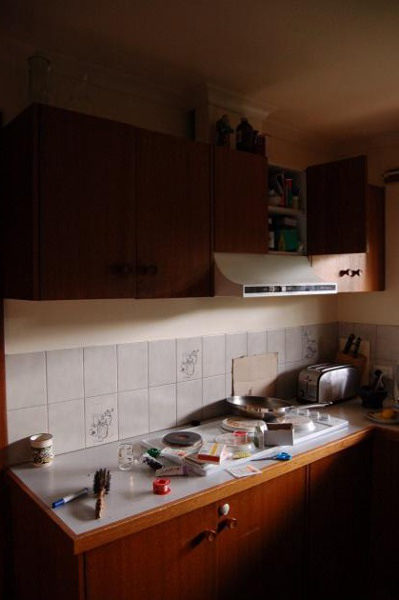
Becky Nevin Berger, Untitled Photographs, Domestic Nexus Series, 2013
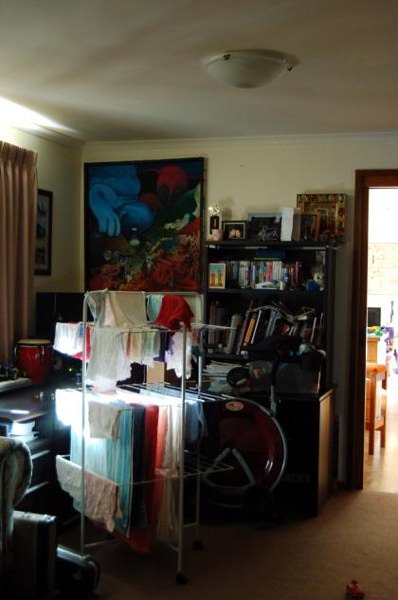
Becky Nevin Berger, Untitled Photographs, Domestic Nexus Series, 2013
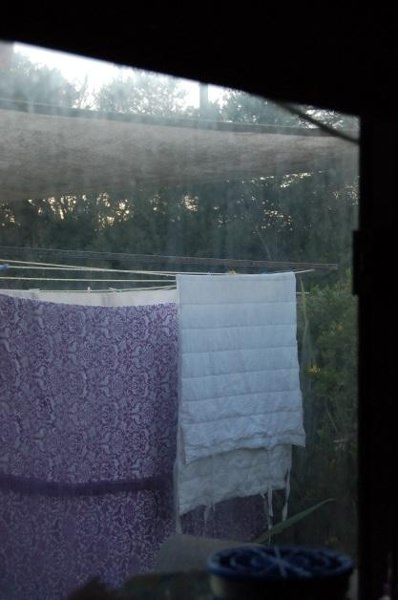
Becky Nevin Berger, Untitled Photographs, Domestic Nexus Series, 2013
During this second year of research I began my weekly trips to Macarthur for my Artist in Schools project. This landscape leaked into my perceptions of my interior domestic space. I would travel west from Warrnambool passing the lookout at Tower Hill on my way. As autumn gave way to winter and a turbulent wet spring I watched farm paddocks green and swell with water. I could see that prior to European agriculture the terrain would’ve carried wetlands, not dissimilar to the one in von Guerard's Tower Hill. In these repeated weekly trips I contemplated the process of constructing spaces as I looked at the buildings and artefacts of dairy farming, cows metabolising pasture, children’s play equipment in farm house yards, and ancient lava flows scattered through rich soil. Contemplating my home’s rooms, sauce jars, milk containers, and my photographs I became more aware of the leakiness of spaces, of their entanglements in other spaces. I thought about the paddocks, factories, truck drivers, waterways and carbon dioxide all entangled and invisible in my ordinary space. I considered how perhaps every act of perceiving is a negotiation between the self’s understanding, desire, needs, and practices, and the environment’s attributes, resources, and resistance, a process that constructs, in varying degrees and duration, a space, a world.
With my attention so closely focused on the small intricacies of domestic life I crafted drawings, smaller sculptures, and written reflections. These too were leaky. I found myself embellishing them with fleshy fabric, waves and clouds not only because I wanted them to be more but because I acutely felt that they were more. The aesthetic qualities of texture, form and surface that we encounter as we handle domestic items become a remembered structure around which we wrap the values and emotional responses that we learn through familial experiences.
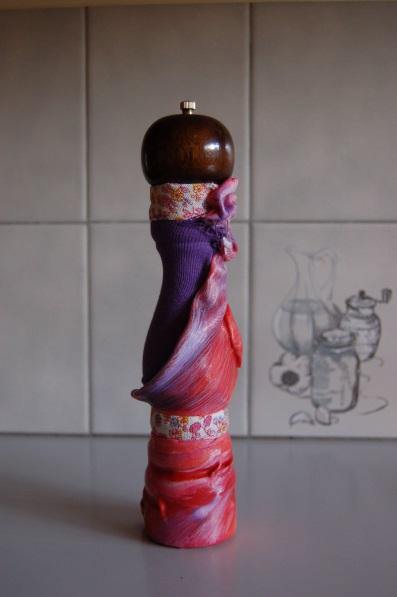
Becky Nevin Berger, Memory Flesh #3, Mixed Media Memory Flesh Milk Series, Plaster and Acrylic Paint, 2013
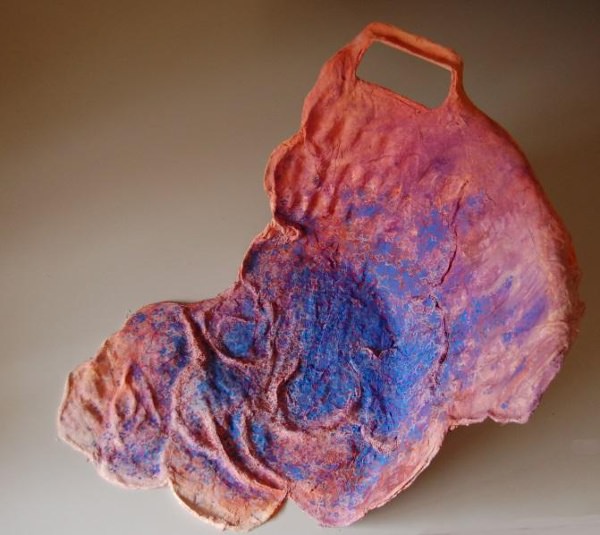
Becky Nevin Berger, Ocean Basket, Plaster and Acrylic Paint, 2013
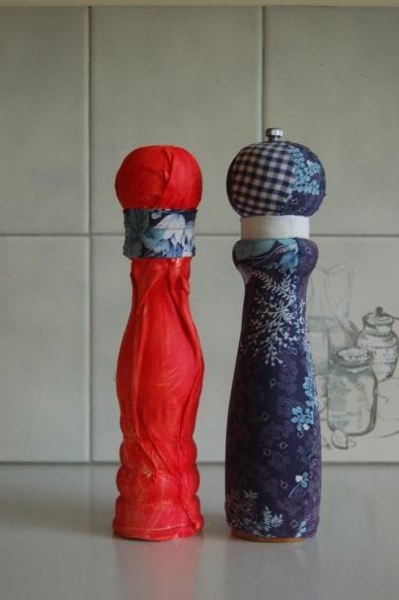
Becky Nevin Berger, Memory Flesh #1, Mixed Media Memory Flesh Milk Series, Plaster and Acrylic Paint, 2013
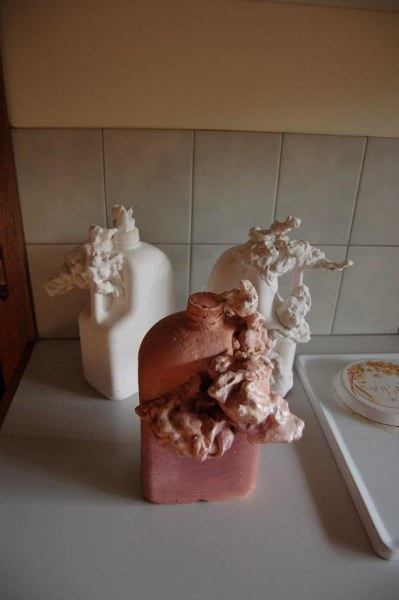
Becky Nevin Berger, Memory Flesh #2, Mixed Media Memory Flesh Milk Series, Plaster and Acrylic Paint, 2013
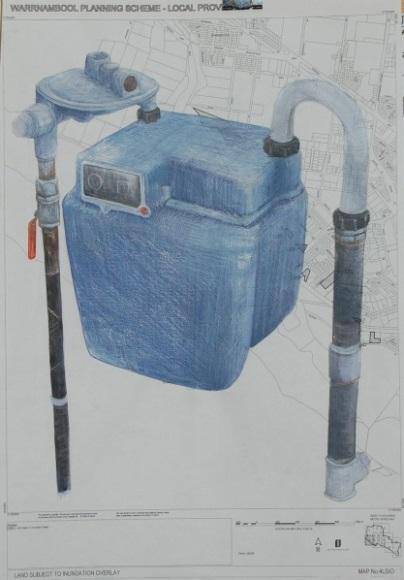
Becky Nevin Berger, Making Spaces #1 Warm Safe House, Acrylic and Pencil on Discarded Map, 2013
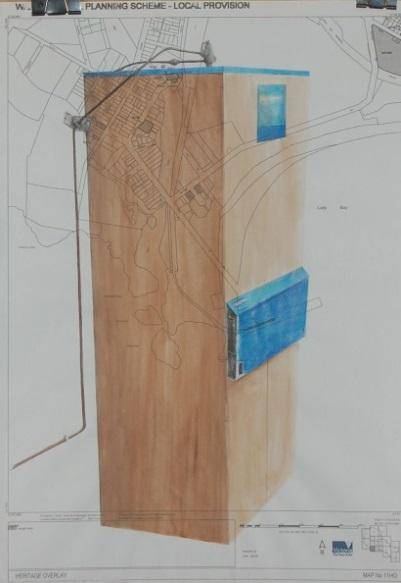
Becky Nevin Berger, Making Spaces #3 Comfort, Acrylic and Pencil on Discarded Map, 2013
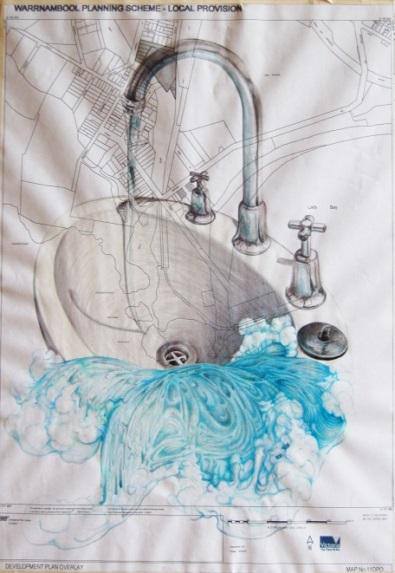
Becky Nevin Berger, Making Spaces #7 Lady Bay, Acrylic and Pencil on Discarded Map, 2013
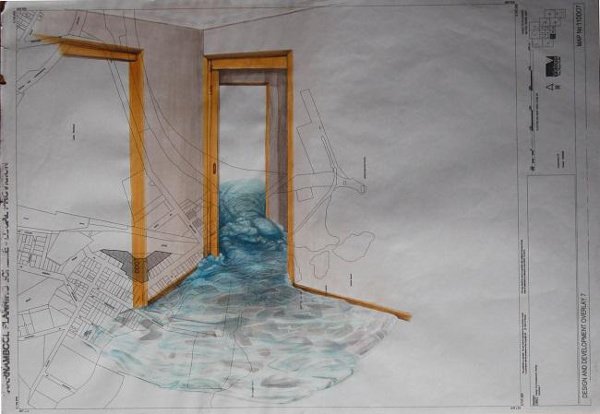
Becky Nevin Berger, Making Spaces #8 Entropy and Apathy, Acrylic and Pencil on Discarded Map, 2013

Becky Nevin Berger, One Day We’ll all be Water, Mixed Media, 2013
It was the water that leaked into these works that became the symbol that I developed. Contemplating my shower as I cleaned it I considered the intersection of ecology, ritual, psyche, brute body and utility that it encompassed. With its muted steam haze and the water’s white noise this architecturally small and confined space is utterly permeated by the external world and utterly permeates subjectivity. I diarised my shower taking over a month and observed the mental and physical transformation immersion in this running stream of water produced. I read Katherine Ashenburg’s The Dirt on Clean and clarified how the West’s early twentieth century’s uptake of beliefs conflated bodily hygiene with moral conventions (229-262). Reflecting upon a simple sense of uncleanliness revealed the complexity of an essentially aesthetic sensibility cultivated within my own body as an intersection between cultural values and norms, water and embodied practices. These ideas culminated in an installation titled Hand Basin Sound Space/Vanity Flesh. I retrieved a discarded bathroom basin from my house and built around it a mirror clad box and swirling water formations made from plaster. Embedded in it and the installation space were a series of speakers that played the sounds of teeth brushing, hand washing and running water interspersed and ultimately dwarfed by the large sound of a crashing wave. As an object in a space the inclusion of sound and the action of the mirror allowed the artwork to mesh into the space. As an artwork within the context of my research it gave me a structure for describing the multi-dimensional leakiness of space I’d observed.
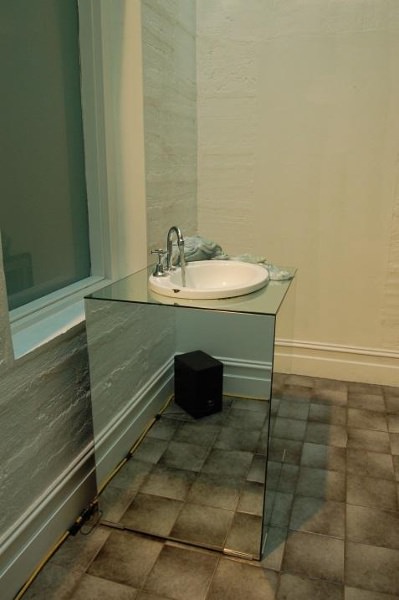
Becky Nevin Berger, Hand Basin Sound Space, Mixed Media Installation, 2013
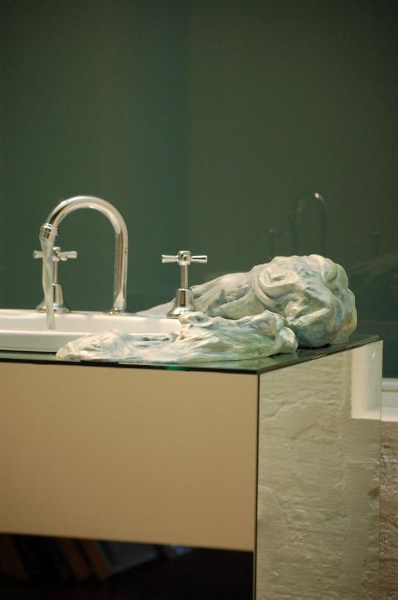
Becky Nevin Berger, Hand Basin Sound Space, Mixed Media Installation, 2013
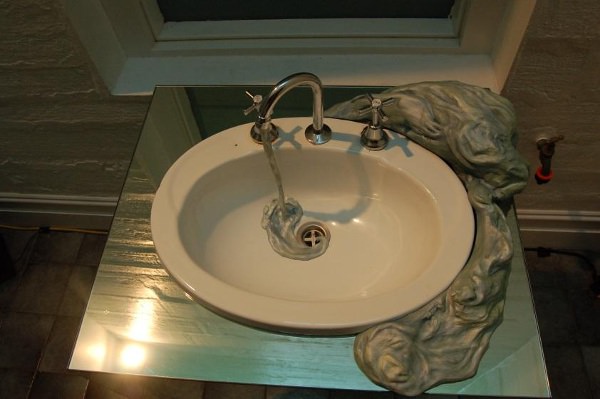
Becky Nevin Berger, Hand Basin Sound Space, Mixed Media Installation, 2013
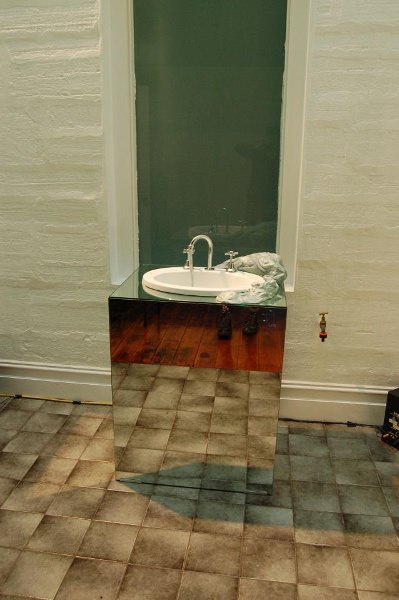
Becky Nevin Berger, Hand Basin Sound Space, Mixed Media Installation, 2013
Contemplating Space
My Phd allowed me to undertake field research in America and Japan in 2014. The purpose of this trip was to experience firsthand a number of sites that exemplified the use of aesthetics in cultivating particular relationships between subject and environment. I visited Pittsburgh’s Mattress Factory, Kanazawa’s Museum of 21st Century Art, installations by Chiharu Shiota, Olafur Eliasson, James Turrell and Pipilotti Rist, architecture by Frank Lloyd Wright and more publicly orientated spaces such as New York’s High Line, Times Square, the 911 Memorial, the Hiroshima Atom Bomb Dome, Tokyo Disney and the art-devoted island of Naoshima. Along with the understanding of spatial practice this array of sites afforded I could not help but observe space creation at a macro level through my immersion in and compliance with spaces such as Tokyo Station and international airports like LAX. The sites I visited were clearly diverse; it is (of course) my experience of a minimalist installation that distills the knowledge acquired from this period of field research. The foreignness of the Western Victorian landscape had enabled an “otherness” to emerge that produced a distance, an objectivity to my place within it.
I entered James Turrell’s 1983 work Pleiades in The Mattress Factory in Pittsburgh. It was impossible to locate to dimensions or to be certain of the depth of the darkened room. Handrails provided a tactile guide to the seat from where to “view” the work. I was aware of the slow adjustment my eyes would need to make. Little coloured dots and faint swirling textures played as I stared. I could almost recognize a faint glow. This ambiguity created interplay between the darkness and my perception. I began to lose a sense of what was happening in my own mind and what was happening out in the space. There seemed to be swirling smoky clouds but I was unsure in which realm they might exist. Intricate patterns unfolded and evolved for two to three minutes before ceasing entirely and revealing themselves as constructs of my own perception. In the darkness I found it difficult to sense the boundary of my own body; I could not distinguish between space external to me and perception of my own form. My eyes continued to adjust and the faint blue light became gradually more sensible. It took on the form of a gaseous star nebula and finally my fuzzy tired eyes conceded that I was staring at an edgeless blue sphere.
The attributes of the environment: its consumption by darkness, the presence of almost imperceptible blue light, its silence, its validation as a Turrell artwork – combined with my agenda for being in the space: namely seeking to understand how different aesthetic processes and techniques create particular spaces – enabled Turrell’s room to wrap around my body and required me to negotiate an experience of space within it. I encountered a dialogue between subjectivity and space in which a perception of a world was created at a most simple level.
This month of field research was bookended by two spaces that layer the most fundamental intersection of body and space found in Pleiades with ritual, furnishings and relative continuity with everyday processes. Both spaces, in keeping with my aforementioned preoccupation, use water as a key medium in their space design. The first is Frank Lloyd Wright’s Fallingwater. Built atop a Pennsylvanian waterfall as a retreat for a wealthy, cultured family this idealized space employs glass, stone, concrete and steel to generate cross sections of nature and domesticity. The second is Shinro Ohtake’s Naoshima Bathhouse. This space fuses pop art and ancient scrolls in a light filled architectural collage that wraps around long established Japanese bathhouse culture. In both these spaces the aesthetic is leveraged to build on that most basic dialogue between body and space. The handling of light, openness and enclosure, the selection of materials and the prescribed activities made possible by the design of each building sets in motion a particular discourse with the space. Both leak: water damage is literally evident to varying degrees in both; but also figuratively, both spaces are entangled in histories and cultural practices, both insist in using glass and other materials to create seeping boundaries between their interiors and exteriors. Moreover the spaces leak into those who encounter them, soaking in through perception and generating affect. In this analysis it becomes obvious that each space we encounter, from the domestic shower to the international airport, permeates us, generates affect and indicates socio-historical milieu just like Upton Sinclair’s “reading” of the Chicago city scape. Wright and Ohtake, like Turrell, do this knowingly and in so doing create not only spaces, but also propose ways of making worlds.
In parallel to the knowledge garnered from following my itinerary I got particular insight from reflecting upon the ways in which I engaged with each site visited. With a limited time in each location I immersed myself, observing different elements and investigating my responses. Drawing, note taking and photography were key means to process my experience and understanding. The attributes of each technique offered a different way to process each space: photography provided a quick way to preserve a visual reference which could later clarify details and prompt memories; writing enabled me to delve into psychological responses and interpretations; drawing allowed me to sustain my attention on the physicality of the site, the visual back and forth revising my perception of scale, position, texture etc. In doing this I was reminded of my long process of photographing my domestic environment. After months documenting my home with my camera I’d realized that with each photograph I negotiated and constructed a space: my eye would pull towards particular scenes, I would demarcate them with my view finder and fix in place a combination of what was and I what saw. I thought about Eugene von Guerard's art led expeditions that constructed a vision of the Australian landscape. I thought about the relationship between making spaces and image making: the discrimination of attention and attributes, the demarcation of borders - what's left outside the picture’s frame, what is included and excluded from the building’s amenity.
Reflecting on the Intersections
There have been three distinct fields examined through my research. As has become clear in this paper, my observations and experiences of these fields have permeated the borders of each. Whilst I imagined this research would yield evidence of the degrees of continuation between subject and environment, I did not predict that I would find continuation between the processes of image making and space making. Not only have my fields of inquiry leaked into each other, but my methodology ultimately leaked into my inquiry. My research has as much investigated the intersections between image making and space making as it has investigated the intersection of body and space. Reviewing these practices in parallel indicates that what we find in image making is not merely metaphoric of how our bodies make the world. Rather, the same iterative processes of perception, negotiation, discernment, demarcation, and action seem to be at play in both. Furthermore, it seems that the aesthetic sinew stretching between embodiment and world provides the medium through which we construct these material spaces in continuum with ourselves.
In her book Installation Art Claire Bishop (37-41) discusses what she terms ‘spectacular immersion’ where artists create large scale works that employ materials that directly evoke meaning and response through their intrinsic attributes. She cites Ann Hamilton’s tropos made from hundreds of severed horse tails and installed as a thick carpet over a gallery floor at the Dia Center New York (Bishop, 39). Rather than representing a concept through visual language alone such works engage the other senses and the body’s movement in the experience and interpretation of the artwork. As an image maker so concerned with space creating I am pulled to think about the affective materiality embodied in visual representations too. Artist and theorist Barbara Bolt (187) proposes that in the process of image making the artist undertakes a productive performativity that transforms materials, artist and the world. Bolt (187) contends that representations do not act as passive illustrations but actively co-produce the world. Images are encoded by the embodied consciousness (and all its entangled culture) that produces them. Simultaneously however, image making co-produces those very embodied psyches offering up templates and maps for their adjoining with the world. In this light consider Ramaswamy’s (12) assertion about the images of empire, that they actively co-constitute its world. In this way we can see image making not merely as illustrative but as directly entwined in the practices of looking, feeling, knowing and relating that co-form our spatial relationships in the world. Constant in all of this is the aesthetic, providing the very fabric of each experience. The aesthetic, like experience itself, is a movement between self and world; the aesthetic is entwined in the action of perception and all the imprints and prejudices and distractions that form it: each act of perception is a multi-directional meaningful sensuousness that creates a space, that discloses a world.
Creating Space
I was invited to present my aerial video in Warrnambool’s Scope Galleries in late 2014. The participatory nature of its production and the unique view it captured already made the video a simultaneous act of image making and space making. I contemplated ways to present it that would draw out the multiplicities of environment and the intersections of space and body with which my logic for the work was concerned. Listening to the troubled cycle of my out-of-balance washing machine as it stalled again and again drew my attention to the ubiquity of its sound: the mundane sense of weight that its banging and whirring could inspire. I considered my feelings about the washing machine in contrast to the awe I felt watching the last minutes of my aerial footage as its frame rocked the boundary between earth and space. I presented the video with the off-kilter sound of my washing machine and along with my ironing board and clothes horse both draped with glossy water like sculptures. The juxtaposition worked. The washing machine’s sound pierced through the picturesque vista of the earths arch and the seemingly disparate spaces of the landscape, the domestic and the global leaked into each other. I realized that this was my response to von Guerard’s Tower Hill: the space created marked the temporally specific position of my own subjectivity within it whilst proposing (visualizing and enacting) a multi-spatial way to imagine and engage with the world.
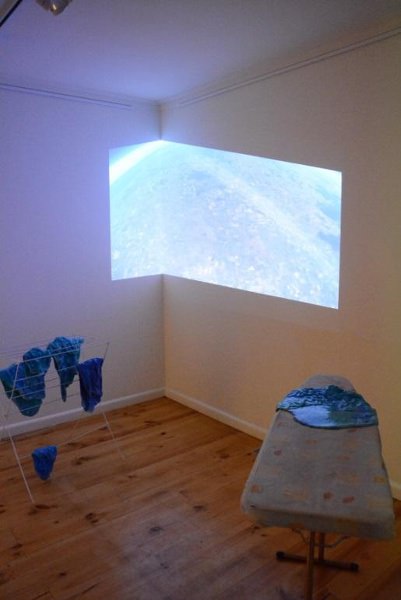
Becky Nevin Berger, Inside Out, Mixed Media Installation, 2014
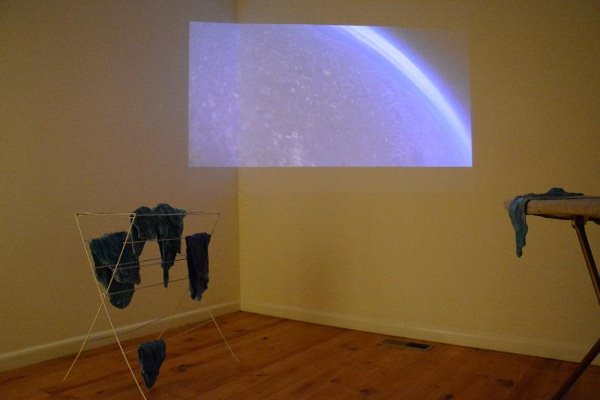
Becky Nevin Berger, Inside Out, Mixed Media Installation, 2014

